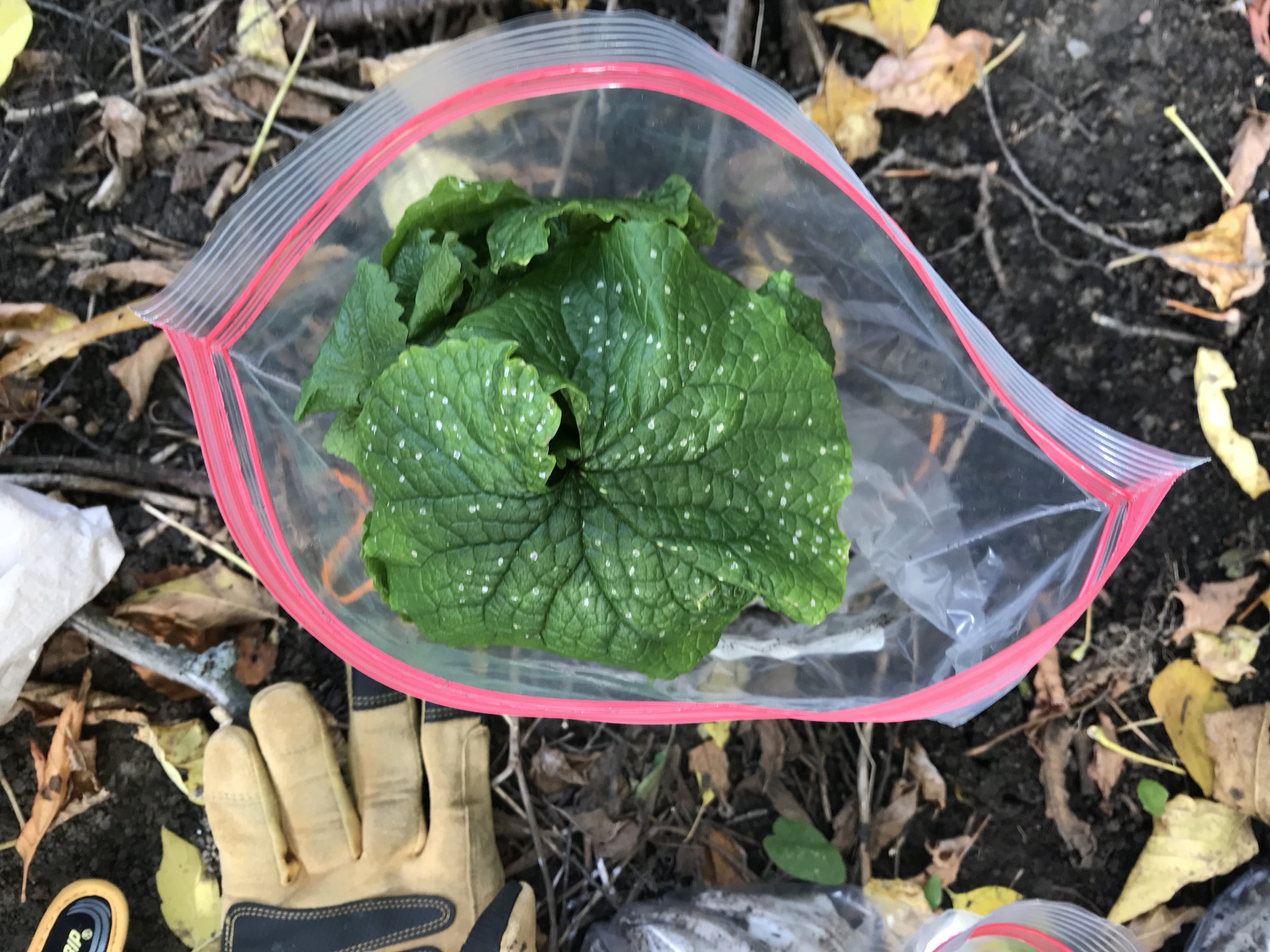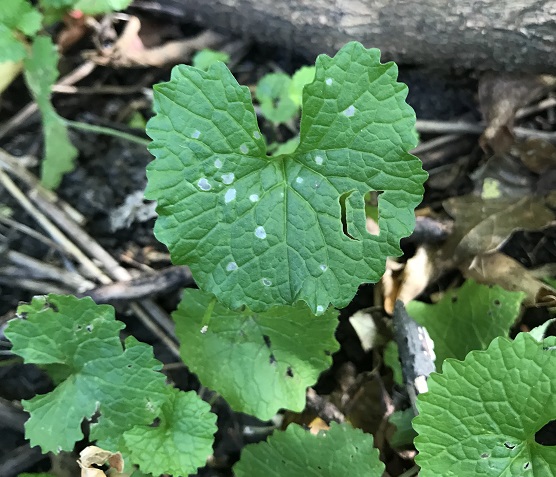
Garlic mustard leaves with typical feeding marks of Ceutorhynchus scrobicollis
In eastern North America a species of weed has become an aggressive invader. Garlic mustard (Alliaria petiolata) is one of the most rapidly increasing woodland invasive plant species, spreading across northeastern and midwestern USA and southeastern Canada at a rate of nearly 2,500 square miles per year.
The plant was most likely introduced to North America in the 19th century, taken from its native habitat of Eurasia by settlers for medicinal and culinary use. Although the crushed leaves and seeds of garlic mustard smell like cultivated garlic and have been used as flavouring in cooking for centuries, the plant actually belongs to the cabbage family.
As an allelopathic herb, garlic mustard releases compounds which inhibit the growth of other plants around, negatively affecting tree seedlings and mycorrhizal fungal* communities. In addition, it contains secondary compounds which act as a defence mechanism to reduce herbivory.
Native North American species suffering from garlic mustard’s proliferation, include the rare West Virginia white butterfly (Pierisvirginiensis). This species normally lays its eggs on native tooth wort (Dentaria spp.), but female butterflies are also attracted to laying on garlic mustard. However, due to the different chemical composition of garlic mustard, larvae are unable to develop on the plant, making it an ecological trap for this important butterfly species.
Garlic mustard is usually found in the undergrowth of disturbed woodlots and forest edges, recent findings have shown that it has the ability to establish and spread even in pristine areas. Garlic mustard is one of very few non-native plants able to successfully invade forest understories with low light levels.
The threat to native ecosystems and lack of competition or natural enemies has made controlling garlic mustard a priority for land managers in the region.
Traditional methods of control are costly, need to be repeated over several years and may face regulatory restrictions. Examples include, hand removal for small infestations and fire, cutting and herbicide treatments for larger infestations.
Biocontrol using natural enemies from the plant’s native habitat could provide a more sustainable solution to controlling garlic mustard in North America.
In August and October 2018, Dr. Rob Bourchier, from Agriculture and Agri-Food Canada (AAFC) released the first biocontrol agent against garlic mustard in North America – the root mining weevil Ceutorhynchus scrobicollis. Weevil larvae in lab-inoculated plants and adults were released at a garlic mustard site in Ontario, Canada.
A population model predicted that of all agents investigated, C. scrobicollis will have the most significant impact on garlic mustard. If the weevils survive the winter and establish themselves in the wild, they are expected to reduce the density of the weed at existing sites and slow its spread to new sites. The project will continue to closely monitor the weevil’s progress and assess whether they live up to the model’s prediction.
The scientific and regulatory process of releasing C. scrobicollis has been years in the making. It started when CABI’s Switzerland centre was commissioned to look for natural enemies of garlic mustard in its native European range in 1998. After initial literature and field surveys, several potential agents (mostly weevils) were studied.

Garlic mustard plant infested with C. scrobicollis larvae planted out at a natural field site in Ontario, Canada, in order to obtain establishment of the weevil
Thorough safety testing done at CABI in Switzerland and under quarantine conditions at the University of Minnesota in the U.S. demonstrated that C.scrobicollis targeted garlic mustard effectively without damaging other native species. Building on this breakthrough, the first petition for field release of the weevil was submitted to the North American regulatory authorities.
Following extensive consultation, supplemental testing and review by regulators, Canada approved the release of the biocontrol agent in June 2018. The research teams are hopeful that a release permit will soon be granted for the United States, which is being pursued by Drs. Jeanie Katovich, Roger Becker, George Heimpel and Ph.D. candidate Mary Marek-Spartz at the University of Minnesota.

Typical feeding marks of C. scrobicollis two months after the first release
In 2019, the weevil rearing program at the University of Minnesota, European field collections by CABI and field expertise from AAFC will be combined to expand the number of weevil release sites in Ontario. These release experiments will focus on defining the conditions that favour C. scrobicollis survival and population growth.
While conducting pre-release studies, researchers collaborating from the U.S., Canada, and CABI have amassed a wealth of experience rearing this insect. This knowledge will be a huge benefit as the teams develop a prescription for the use of C.scrobicollis in North America.
For more information, visit the project page on Biological control of garlic mustard
* Mycorrhizas are fungal associations between plant roots and beneficial fungi.
6 Comments
Leave a Reply
Related News & Blogs
CABI contributes to paper focused on pre-emptive benefit-risk assessment of classical biological control agents
CABI has joined an international team of researchers to share their expertise as part of a new paper focused on guidelines and a framework to assess the feasibility of starting pre-emptive benefit-risk assessment of classical biological control agents…
20 December 2023





Reblogged this on The Invasives Blog.
Will this feed on any of the Cardamine species in Northeast U.S.? This sounds really promising.
Dear Karo,
during pre-release testing we exposed 5 Cardamine species native to North America (C. angustata, C. bulbosa, C. concatenata, C. diphylla and C. pratensis). We found mining and larvae during no-choice tests in C. bulbosa, not in any of the other 4 species. During single-choice tests, i.e. offering C. bulbosa together with garlic mustard, C. bulbosa was not attacked at all. We therefore believe that risk to any of the Cardamine species is extremely low.
Please let me know in case you have any further questions.
Best regards,
Hariet.
Hi. My name is Bob Balcarras. I am an retired Arborist formerly with the City of Waterloo and one of my roles was the inspection of woodlots within Waterloo. Unfortunately I saw Garlic mustard everywhere with no hope of control at that time. I wondered how the program is going and if this weevil can be released in other areas of Ontario as I also know some one who purchased a house with a 16 acre woodlot outside of St Clements. Garlic Mustard is spreading all through it and although I try to help them by removal and cutting off flowers before they go to seed, it is an impossible task when it is so widespread. Any information you could offer would be helpful.
Thank you
Dear Bob,
Robert Bourchier from AAFC was only able to release a low number of specimens twice so far. As far as I know he was not able this spring (due to Covid-19) to check the release site for weevil establishment. We are planning to send more specimens to Canada this autumn. However, these cannot be directly released into the field. Rob and colleagues need to rear these for one generation in the lab to make sure we don’t introduce any parasitoids together with the weevils. So unfortunately I think that it will still take some time before sufficient numbers of the weevil will be available for further re-distribution.
Here the email from Rob in case you would like to contact him directly:
robert.bourchier@canada.ca
Greetings from Switzerland,
Hariet.
Hello.
Wondering if there is an update on weevil release/establishment? Drowning under acres of Alliaria in northern VA!